 |
North
High School Wall of Honor
Clarence Cardwell (Bud) Marchael, Jr.
Class of 1941 |
marchael |
 |
| Research
done by Claradell Shedd, Class of 1953. PAGE IN PROGRESS |
| Clarence
C. (Bud) Marchael |
|
Unknown when he graduated, but we
think Bud graduated in the 1941North High class. He enlisted in the
US Army on October 2, 1941 at Fort Des Moines, IA. At the time of
his enlistment, he was single with no dependents. His service number
was 20704467. Bud's next of kin was listed as Mr. Clarence Cardwell
Marchael, 1069 21st Street, Des Moines, IA.
|
| Clarence C. (Bud) Marchael |
 |
| Year |
|
Rank |
|
Status |
 |
| January,
1936 |
|
Enlisted/
Iowa National Guard |
|
Active in the Guard, as
was his father, Captain Clarence C. Marchael, in command of Company
B of the 168th Infantry, Iowa National Guard |
| 1941 |
x |
US Army |
x |
Received five-year medal
for service with the Iowa National Guard. |
| 1941 |
x |
Graduated or left |
x |
North High School; Des
Moines, IA |
| Oct.2,1941 |
x |
US Army/Enlisted |
x |
Enlisted at Fort Des Moines,
IA. |
| 1941 |
x |
Basic Training |
x |
*Camp Claiborne, LA |
| date |
x |
Enroute |
x |
To **Scotland |
| date |
x |
Enroute |
x |
To ***Kasserine Pass conflict,
Tunisia, North Africa |
April 26,
1943
|
x |
US Army/First
Sergeant |
x |
Killed in action; Kasserine
Pass, Tunisia, North Africa; 168th Infantry Regiment, 34th Infantry
Division, Headquarters Platoon of A Company. |
|
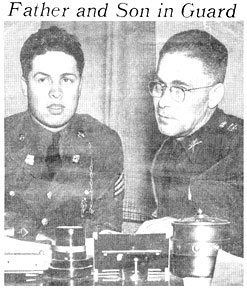 |
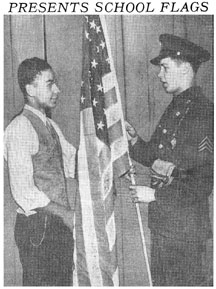 |
| Two members
of the 168th Infantry of the Iowa National Guard are Captain Clarence
C. Marchael, in command of Company B, and his son, Sgt. Clarence
C. Marchael, Jr., who is in Company A. Both live at 1069 Twenty-first
Street |
Sgt. C.C.
Marchael (right), spokesman for group of former North High students
now members of Company A, 168th Infantry, Wednesday presented
the school with four flags during a school assembly. Ozzie Morrow,
North High School student council president, is seen receiving
one of the gifts. (1941) |
|
 |
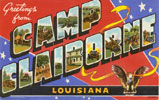
|
|
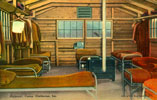 |
|
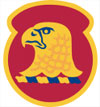 |
| IA National
Guard |
Camp Claiborne,
LA |
Hutment,
Camp Claiborne |
IA National
Guard |
|
**Scotland
This might have pertained to Bud... It was written by a North High grad
who experienced Scotland and then was sent to Kasserine Pass, Tunisia,
North Africa, just as was Clarence C. (Bud) Marchael. They may have
been there together.
In late summer of 1942, we were shipped
to Scotland for amphibious training at the Duke of
Argyle compound of Lake Loman.This area was a real challenge to us;
jagged hills, moors, and peat boggs.
The Duke’s dwelling was
a castle several stories high with moats and draw bridges that we
had to scale by rope after coming ashore from the landing craft.
In the fall of 1942, Churchill
and Roosevelt decided to open a new front in North
Africa to ease pressure off of the Russian front.
There were three major landings planned.
The operation was to be simultaneous and called “Torch” (November
8-12, 1942) at the eastern force at Algiers,
central force at Oran, and western at Casablanca. My combat regiment 168th was to be
with British 78th Division and the 6th Commandos. My troop ship left the British Isles, Glasgow, Scotland,
and Greenock Bay
on the Scotland
Winchester Castle
troop ship. We had the 168th
and 175th Field Artillery Regiments, and the 109th
Engineer and 109th Medical Battalions.
We sailed through the straits
of Gibraltar by cruise ships at night.
Our ships went through first as we were going to the eastern area
to Algiers. We would rendezvous with flotilla from the United States.
The next morning after entering the Mediterranean through the straits, Italian and German aircraft
bombed our convoy all day long. We
lost some ships, but they lost some aircraft. A British major told us to get our machine gun,
30 caliber, up to the top deck and lash the trail legs to the rails
of the troop ship for extra anti-aircraft fire.
Lashing my gun to rails did not work because my ammo belts
could not go through the breech of the gun.
It would jam, and my field of fire was very limited.
The only thing I could shoot was fish.
In reality, my squad saw
action prior to our amphibious assault the morning of November 8,
1942. In the next sequence
of events, the British Navy took us to the wrong beach during the
landing craft assault which in turned out to be okay because we had
to silence the large guns at Fort Sidi Furoh at Algiers and only one
of our objectives, the docks, downtown government buildings, and the
Algiers airport.
All objectives were reached except the harbor area where French ships
were at the quays. The Vichy
French and Italians were our immediate enemy which we soon neutralized,
but they blew up a ship in the harbor to block our ship from coming
into unload troops and supplies. The
night of November 8, 1942, we were hit again with German and Italian
aircraft, and two planes were shot down. I had my first drink of alcohol,
a glass of rum, loading for the landing craft assault. This was because
we were going down rope ladders in the dark with the landing craft
pitching back and forth and up and down, and my whole squad was throwing
up all over each other.
I was a corporal and a squad leader of about seven men.
The machine gun is a water-cooled 30 caliber. It consists of a tripod
and receiver with breech block for rapid fire. Each ammunition canister
has about two hundred and fifty rounds feed through the receiver by
a web belt. The cartridges are usually loaded at the factory with
one ball, one HE and one tracer to view if your line of fire is going
where you want it to go.
My gear for my body was a cartridge belt with a first aid packet,
one-quart water bottle, and cartridges for my 45 caliber revolver.
I always carried at least two hand grenades hooked on my shoulder
harness near my belt line. On my back was my combat pack that carried
my mess kit, C-type or K-type. My half blanket and raincoat hung over
my butt under my cartridge belt. On your side hung a pick and shovel
for digging and chipping the ground and a gas mask with straps.
When you make an amphibious landing, you have to wear a Mae West which
is an inflatable rubber canvas belt with a sparklet cartridge to punch
if the landing party land in waves way over your head or body.
Landing craft assault usually land you right near the beach, depending
on the LST, LCI or submarines for special operations. At Anzio,
Italy,
my squad went ashore in a motorized whale boat.
I always carried the tripod with the three legs unclamped over
my shoulder. My number two guy carried the receiver with the water
can, and the rest of the crew carried the ammunition. Field glasses, night watches, aiming circle,
and clinometers were carried by whoever volunteers to do so.
The first thing I ditched
at the Algiers assault was my gas mask. I forgot we all wore helmets and combat boots
with side straps and buckles. Usually
these boots went to the calf of your leg.
At daylight the first few
guys I saw killed were not ours. They
were British Commandos. There were quite a few body parts on the beach
sand. I had a guy in my squad
that was quite mechanical, so we knocked the window out of an electrical
trolley and hoped it would take us down town and that was the case. We saved walking five miles and for not knowing
who our enemies were, it went well.
Of all the troops we confronted, most were Vichy French, Arabs
and Italians.
Colonel Doyle was at my side and he was killed
shot by sniper fire between the eyes on Main
Street in downtown Algiers. The
shot came from a Casbah Roe house’s second balcony fifty to seventy
five yards away, so I unloaded
several canisters of ammo and about 35 enemy soldiers were killed. It looked like a cyclone had hit that balcony,
with people screaming and crying and dead civilians and chickens and
laundry scattered everywhere. But
war is hell and lots of innocent people die.
This was my first act of death after seeing Colonel Doyle’s shattered
head around me.
After downtown Algiers was
secured, they moved my company to the high ground near one of Algiers’s two airports. We were dive bombed
and strafed constantly by German and Italian aircraft. They came in
real low and fast dropping flares for night visibility. The gear each
man carries is usually one hundred plus pounds in a machine gun crew
and your personal equipment.
The British and American Navies had destroyed ten French ships and four
submarines at all three landings by November 10, 1942.The Algiers,
Oran, and Casablanca
operation “Torch” was a success.
Christmas was planned between Algeria
and Tunisia
on a train our engineers ran. We continued getting lots more supplies
and manpower.
We even got to see Bob Hope, Jerry Colona, and Francis Langford. They
used a flatbed semitrailer for a stage. We could only go in groups due
to constant air attacks. We were at Tebesa near the border of Tunisia guarding
the airstrip. Then they moved us to Constantine
where Cleopatra bathed in the warm mineral water coming from the ground.
We found ourselves in combat, in the same general area, as the Roman
legions fought in 400 A.D. In January of 1943, my unit was assembled
and trucked to jump off the area in front of Sened Station on the main
rail link to all major ports of Tunisia, Bizerta,
Tunis, Sfax, Sousse,
and Cape Bon.
It was at this battle I killed my first Italians and Germans.
We took eighteen Italian POWs.
Tunisia
is a country about 160 miles east to west and 500 north to south. The
main spine is the Atlas Mountains with
mountain passes controlling all roadways, (wadis) rivers, and rail lines.
British Field Marshall Montgomery was driving Germans north along the
coast with lots of German casualties along the way. It was imperative
to close the German troop movements and supplies from the ports of Tunis.
My unit fought at Faid Pass,
Kasserine Pass,
Fondoak and Sidi Hill 609 Bel Alis.
We were part of the II Corp under General George Patton, 1st
Division, 9th Division and 3rd Division, 1st
and 2nd Armored, 175th and 151st Field
Artilleries, 2nd Tank Destroyer Battalion, and the 109th
Engineer and 109th Medical Battalions. |
***Kasserine
Pass
Upon mobilization on February 10, 1941, the 34th Division went into
intensive training at Camp Claiborne, Louisiana. After the bombing of
Pearl Harbor, the 34th Division was chosen to be one of the first divisions
sent overseas. From Louisiana, the Division was sent to Fort Dix, New
Jersey, and then to Ireland for additional training. In November of
1942, the 34th took part in "Operation Torch," the Allied
landing on German occupied North Africa. The Division was involved in
numerous battles, such as Kasserine Pass, Fondouk Pass, Faid Pass, as
well as Allied landings at Algiers and Tunis. By the time the Germans
surrendered at Tunis in May of 1943, many brave men of the 34th had
given their lives for their country. In Italy, the men of the 34th,
also known as the Red Bull Division, were involved in the battles of
Naples, Anzio, Cassino, Rome-Arno, North Apennines, and the Po Valley,
where the U. S. 34th Division captured the German 34th Division to end
the war in Italy.
|
| Note: Clarence
Marchael, Jr. served in the same Division as Eugene
R. Brown and Fred Emerling;
from the class of 1940. |
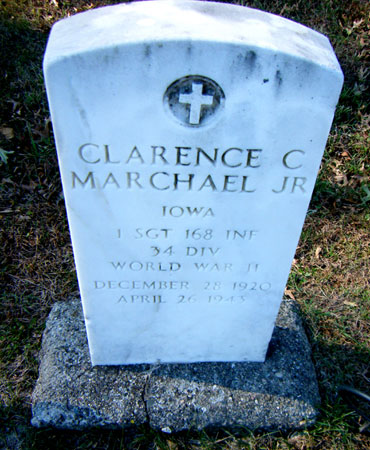 |
| Glendale Cemetery; Memorial
#83676909 |
|
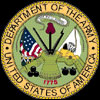
|
Clarence
C. (Bud) Marchael
First Sergeant
Company A
168th Infantry Regiment
34th Infantry Division
Iowa National Guard

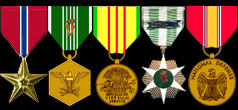
Examples: Bronze Star, Army Commendation
Medal w/1st OLC,
and V (valor) device, Vietnam Service Medal,
Vietnam Campaign Medal,
National Defense Service Medal |
|
| References |
(1)
Information was obtained from the Records on Military Personnel
Who Died, were Missing in Action, or Prisoners of War as a result
of the Vietnam War. This document can be found online at the National
Archives and Records Administration at http://www.archives.gov/.
(2) The comprehensive list of names from North High's 1893-2018
graduation classes are from Claradell Shedd's North Des Moines
High School website. The names of North High School graduates
can be found online at:http://www.ndmhs.com/.
Clarence C. (Bud) Marchael's 1941 class page is: http://www.ndmhs.com/pages/yearclass1941(2001.60).html. |
|
|
Died 04/26/43. |
| Music:
"Wind Beneath My Wings" |
Home
|
Back/allyears |
WWI |
WWII |
Korea |
Vietnam |
Afghanistan/Iraq |
Lyrics
|
Refs/Awards |
Contact
©2023-csheddgraphics All rights reserved.
All images and content are © copyright of their respective copyright
owners. |
|








